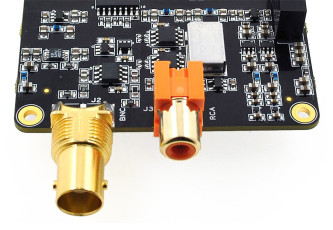Allo DigiOne SPDIF digital audio HAT for Raspberry Pi
March 14, 2019
on
on
 The correlation between the price of audio equipment and the perceived audio result is a subject widely discussed. All the more delicate since electronics has been used to (re)produce the music. It’s still a hot topic, subjectivity reigns and resists assaults from rational measurements. Better still, this subjectivity feeds on technical arguments. The digitalization of the audio reproduction signal chain has not made any difference. As they relate to perceptions, the exorbitant price differences between devices cannot be made to seem reasonable. As the imponderables cannot be reduced to a tangible reality, one has a tendency to accept the high prices as a (supposed) guarantee of quality.
The correlation between the price of audio equipment and the perceived audio result is a subject widely discussed. All the more delicate since electronics has been used to (re)produce the music. It’s still a hot topic, subjectivity reigns and resists assaults from rational measurements. Better still, this subjectivity feeds on technical arguments. The digitalization of the audio reproduction signal chain has not made any difference. As they relate to perceptions, the exorbitant price differences between devices cannot be made to seem reasonable. As the imponderables cannot be reduced to a tangible reality, one has a tendency to accept the high prices as a (supposed) guarantee of quality.
Emphasis on vocabulary
With audio, the role of vocabulary is crucial. It gives emphasis to oh-so-lyrical flights of fancy. Have you noticed how the art of sound reproduction is above all an art of oratory? As formerly “high fidelity” was so dear to the nascent techniques of audio reproduction, the qualifiers of today are equally emphatic. After the waltz of the price tickets, there is talk of purity, clarity, integrity, of absence of compromise, etc.Our subject this week is, to be precise, an S/PDIF digital output stage for the Raspberry Pi, a fairly ambitions HAT. Its moderate price keeps it with reach of tight budgets.
Ears open, feet on the ground
This video has been on my list for some time, because Elektor sells this card, but I was hesitant… I am interested in sounds (rather than sound) in the production, recording and reproduction of sounds and music. On the other hand, I have trouble following recipes for sound reproduction which seem to be technical but of which, in the end, I hear nothing (in the double sense of understand and perceive).If I end up by offering it here, it is because its author has the good sense to keep his feet firmly on the ground. He relates a significant anecdote from his personal experience. During his comparative tests, he fortuitously realizes that one of his items of test gear (even though off) is interfering with the signal path to which he was still connected. One can guess that this interference came from its switching power supply.
Mr Hans Beekhuyzen has written his critique with care, and delivers it in an intelligible fashion. Another reason to listen until the end, and appreciate it: he does not forget to put his appreciation in context. A product which is accessible today, and thus not too expensive, would a few years ago have passed for a top-of-the-range product, thus expensive. All this depends, of course, because at the time such a product probably did not exist!
Read full article
Hide full article



Discussion (0 comments)